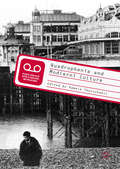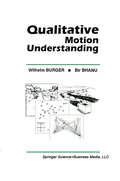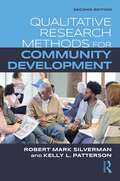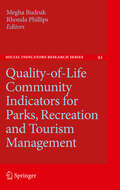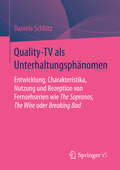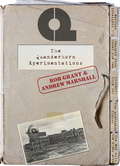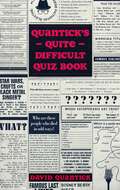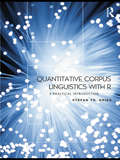- Table View
- List View
Quadrophenia and Mod(ern) Culture
by Pamela ThurschwellThis collection explores the centrality of The Who’s classic album, and Franc Roddam’s cult classic film of adolescent life, Quadrophenia to the recent cultural history of Britain, to British subcultural studies, and to a continuing fascination with Mod style and culture. The interdisciplinary chapters collected here set the album and film amongst critical contexts including gender and sexuality studies, class analysis, and the film and album’s urban geographies, seeing Quadrophenia as a transatlantic phenomenon and as a perennial adolescent story. Contributors view Quadrophenia through a variety of lenses, including the Who’s history and reception, the 1970s English political and social landscape, the adolescent novel of development (the bildungsroman), the perception of the film through the eyes of Mods and Mod revivalists, 1970s socialist politics, punk, glam, sharp suits, scooters and the Brighton train, arguing for the continuing richness of Quadrophenia’s depiction of the adolescent dilemma. The volume includes new interviews with Franc Roddam, director of Quadrophenia, and the photographer Ethan Russell, who took the photos for the album’s famous photo booklet.
Quadrophenia and Mod(ern) Culture
by Pamela ThurschwellThis collection explores the centrality of The Who’s classic album, and Franc Roddam’s cult classic film of adolescent life, Quadrophenia to the recent cultural history of Britain, to British subcultural studies, and to a continuing fascination with Mod style and culture. The interdisciplinary chapters collected here set the album and film amongst critical contexts including gender and sexuality studies, class analysis, and the film and album’s urban geographies, seeing Quadrophenia as a transatlantic phenomenon and as a perennial adolescent story. Contributors view Quadrophenia through a variety of lenses, including the Who’s history and reception, the 1970s English political and social landscape, the adolescent novel of development (the bildungsroman), the perception of the film through the eyes of Mods and Mod revivalists, 1970s socialist politics, punk, glam, sharp suits, scooters and the Brighton train, arguing for the continuing richness of Quadrophenia’s depiction of the adolescent dilemma. The volume includes new interviews with Franc Roddam, director of Quadrophenia, and the photographer Ethan Russell, who took the photos for the album’s famous photo booklet.
Quakers and their Meeting Houses
by Chris SkidmoreThis book provides a fascinating account of the architecture and historical development of the Quaker meeting house from the foundation of the movement to the twenty-first century. The Quaker meeting house is a distinctive building type used as a place of worship by members of the Society of Friends (Quakers). Starting with buildings of the late-seventeenth century, the book maps how the changing beliefs and practices of Quakers over the last 350 years have affected the architecture of the meeting house. The buildings considered are illustrated, predominantly in colour, and are from England, Scotland and Wales, with some consideration of colonial American examples. The book commences with an introduction which provides an accessible account of the early history of Quakerism and it concludes with a consideration of whether there is a Quaker architectural style and of what it might consist.
Qualitative Analysis for Planning & Policy: Beyond the Numbers
by John GaberThe revised and updated second edition of Qualitative Analysis for Planning & Policy is a roadmap to help planners access qualitative data and integrate it into their planning investigations. Planning and policy decisions are not based solely on numbers, and this book equips planners with a how-to guide to see what has been missing "between the lines" of quantitative data and make good decisions using the best possible information. Each chapter offers step-by-step instruction on how to set up and enact diverse types of qualitative research, and case studies demonstrate how qualitative research techniques can be combined with quantitative methods to tackle complex real-world projects. For over a decade Qualitative Analysis for Planning & Policy has been an indispensable resource for students and researchers, experienced and novice planners. The revised second edition offers myriad tools to help twenty-first-century planners make intelligent decisions, including new qualitative research techniques, technological innovations, and contemporary case studies.
Qualitative Analysis for Planning & Policy: Beyond the Numbers
by John GaberThe revised and updated second edition of Qualitative Analysis for Planning & Policy is a roadmap to help planners access qualitative data and integrate it into their planning investigations. Planning and policy decisions are not based solely on numbers, and this book equips planners with a how-to guide to see what has been missing "between the lines" of quantitative data and make good decisions using the best possible information. Each chapter offers step-by-step instruction on how to set up and enact diverse types of qualitative research, and case studies demonstrate how qualitative research techniques can be combined with quantitative methods to tackle complex real-world projects. For over a decade Qualitative Analysis for Planning & Policy has been an indispensable resource for students and researchers, experienced and novice planners. The revised second edition offers myriad tools to help twenty-first-century planners make intelligent decisions, including new qualitative research techniques, technological innovations, and contemporary case studies.
Qualitative Analysis for Planning & Policy: Beyond the Numbers
by John Gaber Sharon GaberThis book explains how to use and adapt these techniques and how to integrate these methods with more traditional qualitative research. Chapters offer step-by-step guidance to setting up various kinds of qualitative research projects, collecting data, organizing data, and analyzing data. Case studies show how a mix of qualitative and quantitative research can help planners build consensus and tackle large, complicated projects.
Qualitative Analysis for Planning & Policy: Beyond the Numbers
by John Gaber Sharon GaberThis book explains how to use and adapt these techniques and how to integrate these methods with more traditional qualitative research. Chapters offer step-by-step guidance to setting up various kinds of qualitative research projects, collecting data, organizing data, and analyzing data. Case studies show how a mix of qualitative and quantitative research can help planners build consensus and tackle large, complicated projects.
Qualitative Motion Understanding (The Springer International Series in Engineering and Computer Science #184)
by Wilhelm Burger Bir BhanuMobile robots operating in real-world, outdoor scenarios depend on dynamic scene understanding for detecting and avoiding obstacles, recognizing landmarks, acquiring models, and for detecting and tracking moving objects. Motion understanding has been an active research effort for more than a decade, searching for solutions to some of these problems; however, it still remains one of the more difficult and challenging areas of computer vision research. Qualitative Motion Understanding describes a qualitative approach to dynamic scene and motion analysis, called DRIVE (Dynamic Reasoning from Integrated Visual Evidence). The DRIVE system addresses the problems of (a) estimating the robot's egomotion, (b) reconstructing the observed 3-D scene structure; and (c) evaluating the motion of individual objects from a sequence of monocular images. The approach is based on the FOE (focus of expansion) concept, but it takes a somewhat unconventional route. The DRIVE system uses a qualitative scene model and a fuzzy focus of expansion to estimate robot motion from visual cues, to detect and track moving objects, and to construct and maintain a global dynamic reference model.
Qualitative Research Methods for Community Development
by Robert Mark Silverman Kelly PattersonThe second edition of Qualitative Research Methods for Community Development teaches the basic skills, tools, and methods of qualitative research with special attention to the needs of community practitioners. This book teaches students entering planning, community development, nonprofit management, social work, and similar applied fields the core skills necessary to conduct systematic research designed to empower communities and promote social change.Focusing on the basic elements of qualitative research, such as field observation, interviewing, focus groups, and content analysis, this second edition of this book provides an overview of core methods and theoretical underpinnings of successful research. It also includes two new chapters on qualitative data analysis software and techniques for conducting online qualitative interviews and focus groups.From housing, community organizing, neighborhood planning, and urban revitalization, this book gives students the skills they need to undertake their own projects and provides professionals a valuable reference for their future research. This book serves as a primary text for courses in applied qualitative research and as a reference book for professionals and community-based researchers.
Qualitative Research Methods for Community Development
by Robert Mark Silverman Kelly PattersonThe second edition of Qualitative Research Methods for Community Development teaches the basic skills, tools, and methods of qualitative research with special attention to the needs of community practitioners. This book teaches students entering planning, community development, nonprofit management, social work, and similar applied fields the core skills necessary to conduct systematic research designed to empower communities and promote social change.Focusing on the basic elements of qualitative research, such as field observation, interviewing, focus groups, and content analysis, this second edition of this book provides an overview of core methods and theoretical underpinnings of successful research. It also includes two new chapters on qualitative data analysis software and techniques for conducting online qualitative interviews and focus groups.From housing, community organizing, neighborhood planning, and urban revitalization, this book gives students the skills they need to undertake their own projects and provides professionals a valuable reference for their future research. This book serves as a primary text for courses in applied qualitative research and as a reference book for professionals and community-based researchers.
Qualitative Spatial Reasoning with Topological Information (Lecture Notes in Computer Science #2293)
by Jochen RenzSpatial knowledge representation and reasoning with spatial knowledge are relevant issues for many application areas such as robotics, geographical information systems, and computer vision. Exceeding purely quantitative approaches, more recently initiated qualitative approaches allow for dealing with spatial information on a more abstract level that is closer to the way humans think and speak.Starting out with the qualitative, topological constraint calculus RCC8 proposed by Randell, Cui, and Cohn, this work presents answers to a variety of open questions regarding RCC8. The open issues concerning computational properties are solved by exploiting a broad variety of results and methods from logic and theoretical computer science. Questions concerning practical performance are addressed by large-scale empirical computational experiments. The most impressive result is probably the complete classification of computational properties for all fragments of RCC8.
Qualitätsserien aus Deutschland: Produktionspraktiken, Erzählweisen und Transformationen des Fernsehens (Produktionskulturen der Medien)
by Florian KraußDas Buch untersucht, wie die Fernsehschaffenden in Deutschland sogenannten Qualitätsfernsehserien von 2015 bis heute entwickeln. Dabei ist die zentrale Hypothese, dass diese Praktiker das Qualitätsfernsehen, das am stärksten mit dem Serien-Drama aus den USA assoziiert wird, in einen nationalen Kontext übertragen und gleichzeitig dieses Konzept mit breiteren, jüngeren Transformationen des Fernsehens und der lokalen Fernsehindustrie verbinden.
Qualitätssicherung und Dauerhaftigkeit von Stahlbetonbauwerken (Rheinisch-Westfälische Akademie der Wissenschaften #390)
by Friedhelm StangenbergQuality Assessment of Visual Content (Advances in Computer Vision and Pattern Recognition)
by Ke Gu Hongyan Liu Chengxu ZhouThis book provides readers with a comprehensive review of image quality assessment technology, particularly applications on screen content images, 3D-synthesized images, sonar images, enhanced images, light-field images, VR images, and super-resolution images. It covers topics containing structural variation analysis, sparse reference information, multiscale natural scene statistical analysis, task and visual perception, contour degradation measurement, spatial angular measurement, local and global assessment metrics, and more. All of the image quality assessment algorithms of this book have a high efficiency with better performance compared to other image quality assessment algorithms, and the performance of these approaches mentioned above can be demonstrated by the results of experiments on real-world images. On the basis of this, those interested in relevant fields can use the results obtained through these quality assessment algorithms for further image processing. The goal of this book is to facilitate the use of these image quality assessment algorithms by engineers and scientists from various disciplines, such as optics, electronics, math, photography techniques and computation techniques. The book can serve as a reference for graduate students who are interested in image quality assessment techniques, for front-line researchers practicing these methods, and for domain experts working in this area or conducting related application development.
Quality Hollywood: Markers of Distinction in Contemporary Studio Film (International Library of the Moving Image (PDF))
by Geoff KingWhat defines 'quality' in contemporary Hollywood film? Although often seen as inhospitable to such work, the studios of the blockbuster-franchise era continue to produce features that make claims to higher status. Films such as The Social Network, The Assassination of Jesse James by the Coward Robert Ford and Mystic River are marked as distinctive from the mainstream norm. But how exactly, and how are such qualities mixed with more familiar Hollywood ingredients, as found in larger doses in other examples such as Blood Diamond and the blockbuster-scale Inception?Quality Hollywood is the first book to address these issues, featuring close analysis of case study films, critical responses and the wider notions of cultural value on which these draw. Geoff King argues that such films retain a presence as a minority strand of studio output. The reasons for this combine factors relating to economics, the power of certain filmmakers and Hollywood's investment in its own prestige.
Quality-of-Life Community Indicators for Parks, Recreation and Tourism Management (Social Indicators Research Series #43)
by Megha Budruk and Rhonda PhillipsWhile community quality-of-life indicators are gaining much needed attention in both scholarly work and practice, their application in the areas of parks, recreation and tourism management are not as well known. The applicability of indicator systems for natural resource and natural resource area management within the parks and recreation arena is very high, including urban parks and recreation programs and their influence on quality of life. Tourism is also an area that needs much more work in terms of assessing impacts as well as developing indicators for gauging progress in the long term. All three areas are an integrated discipline and most programs throughout the developed world are housed co-jointly. There are several researchers across the globe who are conducting innovative work in these areas. The editors feel that a volume on the topic will spur additional interests as well as serve to lead the research efforts.
Quality TV: Contemporary American Television and Beyond
by Janet McCabe Kim AkassIn his seminal book "Television's Second Golden Age", Robert Thompson described quality TV as 'best defined by what it is not': 'it is not "regular" TV'. Audacious maybe, but his statement renewed debate on the meaning of this highly contentious term. Dealing primarily with the post-1996 era shaped by digital technologies and defined by consumer choice and brand marketing, this book brings together leading scholars, established journalists and experienced broadcasters working in the field of contemporary television to debate what we currently mean by quality TV. They go deep into contemporary American television fictions, from "The Sopranos" and "The West Wing", to "CSI" and "Lost" - innovative, sometimes controversial, always compelling dramas, which one scholar has described as 'now better than the movies!' But how do we understand the emergence of these kinds of fiction? Are they genuinely new? What does quality TV have to tell us about the state of today's television market? And is this a new Golden Age of quality TV? Original, often polemic, each chapter proposes new ways of thinking about and defining quality TV.There is a foreword from Robert Thompson, and heated dialogue between British and US television critics. Also included - and a great coup - are interviews with W. Snuffy Walden (scored "The West Wing" among others) and with David Chase ("The Sopranos" creator). "Quality TV" provides throughout groundbreaking and innovative theoretical and critical approaches to studying television and for understanding the current - and future - TV landscape.
Quality TV: Contemporary American Television and Beyond (Reading Contemporary Television)
by Janet McCabe Kim AkassIn his seminal book'Television's Second Golden Age', Robert Thompson described quality TV as 'best defined by what it is not': 'it is not “regular” TV'. Audacious maybe, but his statement renewed debate on the meaning of this highly contentious term. Dealing primarily with the post-1996 era shaped by digital technologies and defined by consumer choice and brand marketing, this book brings together leading scholars, established journalists and experienced broadcasters working in the field of contemporary television to debate what we currently mean by quality TV. They go deep into contemporary American television fictions, from 'The Sopranos' and 'The West Wing', to 'CSI' and 'Lost' - innovative, sometimes controversial, always compelling dramas, which one scholar has described as 'now better than the movies!' But how do we understand the emergence of these kinds of fiction? Are they genuinely new? What does quality tv have to tell us about the state of today's television market? And is this a new Golden Age of quality TV? Original, often polemic, each chapter proposes new ways of thinking about and defining quality TV. There is a foreword from Robert Thompson, and heated dialogue between British and US television critics. Also included - and a great coup - are interviews with W. Snuffy Walden (scored 'The West Wing' among others) and with David Chase ('The Sopranos' creator). 'Quality TV' provides throughout groundbreaking and innovative theoretical and critical approaches to studying television and for understanding the current - and future - TV landscape.
Quality-TV als Unterhaltungsphänomen: Entwicklung, Charakteristika, Nutzung und Rezeption von Fernsehserien wie The Sopranos, The Wire oder Breaking Bad
by Daniela SchlützAusgangspunkt des Buches ist die Auseinandersetzung mit sogenannten Qualitätsserien als prototypische Produkte des Fernsehens im Zeitalter der kulturellen Konvergenz. Es wird angenommen, dass Qualitätsunterhaltung eine besondere kulturell gebundene, komplexe und bereichernde Rezeptionserfahrung ermöglicht. Sie dient – so das Argument – daher als Nachfragetreiber in einer direkten Produkt-KundInnen-Beziehung. Die Besonderheit des Buches besteht in der Integration unterschiedlicher kommunikations- und medienwissenschaftlicher, medienpsychologischer aber auch ökonomischer Ansätze im Modell des Quality-TV-Unterhaltungserlebens (QTV-UE). Ziel ist ein umfassenderes Verständnis des Wechselspiels von Produktion, Allokation und Rezeption qualitativ hochwertiger, unterhaltsamer Kreativgüter.
The Quanderhorn Xperimentations
by Rob Grant Andrew MarshallADAPTED BACKWARDS VIA THE FUTURE FROM THE RADIO 4 SERIES BEFORE IT WAS MADE A richer, deeper, more comprehensive exploration of the Quanderhorn phenomenon. With added secrets.England, 1952.A time of peace, regeneration and hope. A Golden Age.Unfortunately, it's been 1952 for the past 65 years.Meet Professor Quanderhorn: a brilliant, maverick scientific genius with absolutely no moral compass. Assisted by a rag-tag crew - his part-insect "son" (reputedly 'a major breakthrough in Artificial Stupidity'), a recovering amnesiac, a brilliant scientist with a half-clockwork brain, and a captured Martian hostage - he'll save the world.Even if he has to destroy it in the process.With his Dangerous Giant Space Laser, Utterly Untested Matter Transfuser Booth and Fleets of Monkey-driven Lorries, he's not afraid to push the boundaries of science to their very limit.And far, far beyond ...
Quantick's Quite Difficult Quiz Book
by David Quantick'Best quiz book ever'HARRY HILL'Quantick is the Captain Beefheart of quizzing'MARK BILLINGHAM'The antidote to every deathly dull pub quiz you've ever been to. This is how a quiz book should be written - where having fun is the most important outcome'GARY WIGGLESWORTH, author of The Book Lover's Quiz BookDistinctive, unusual, difficult, but spectacularly entertaining, this quiz book is to other pub quizzes what Trivial Pursuit was to Ludo, what The Hitch-Hiker's Guide to the Galaxy is like to the Rhyl phone directory, and what the Rolls-Royce Silver Ghost is like compared to a kid's scooter. Loads better.David Quantick works regularly with Armando Iannucci, including on the new HBO series, Avenue 5. He won an Emmy as part of the writing team on Veep, a BAFTA for Harry Hill's TV Burp and a Writers' Guild Award for The Thick of It. For over fifteen years, David has also hosted his own very popular quizzes at festivals, events, pubs, clubs, cinemas and in tents: the quizzes range is broad and the questions are tricky. They're not about statistics, there's no sport, the picture rounds are conceptual, and there's sometimes a round called 'Martin Amis Character or Blur Song'. Each quiz is funny and entertaining even if you don't know the answers. The quizzes are informative and opinionated. In some ways, they're like stand-up with questions. This is a book based on David's excellent live quizzes, described by many people as 'quite difficult'.But they are quizzes. Quite difficult quizzes that tax the brain and make it go in directions it didn't know it could. That's not to say the questions are fiendishly scientific and packed with questions about dates and the periodic table. They're about books and music, movies and actors, strange events and interesting quotes. You don't leave a Quantick quiz knowing how many times Spurs have won the League, but you may know how many Shirleys have sung a Bond theme or how George V made the front page of The Times.The effectiveness of David's quizzes is down to their unusual variety and almost stream-of-consciousness leaps and bounds of factual imagination. There's not even much point in cheating, because the answers often require mental agility as well as just knowing where Calais is (it's in France, but it wasn't always, even when it was).David's quiz book includes twenty-five main quizzes, four Christmas quizzes and four specialist quizzes, so thirty-three quizzes in total. Entertaining in its own right, this is also a conceptual yet very practical guide to staging excellent quizzes of your own.
Quantitative Corpus Linguistics with R: A Practical Introduction
by Stefan Th. GriesThe first textbook of its kind, Quantitative Corpus Linguistics with R demonstrates how to use the open source programming language R for corpus linguistic analyses. Computational and corpus linguists doing corpus work will find that R provides an enormous range of functions that currently require several programs to achieve – searching and processing corpora, arranging and outputting the results of corpus searches, statistical evaluation, and graphing.
Quantitative Corpus Linguistics with R: A Practical Introduction
by Stefan Th. GriesThe first textbook of its kind, Quantitative Corpus Linguistics with R demonstrates how to use the open source programming language R for corpus linguistic analyses. Computational and corpus linguists doing corpus work will find that R provides an enormous range of functions that currently require several programs to achieve – searching and processing corpora, arranging and outputting the results of corpus searches, statistical evaluation, and graphing.
Quantitative Corpus Linguistics with R: A Practical Introduction
by Stefan Th. GriesAs in its first edition, the new edition of Quantitative Corpus Linguistics with R demonstrates how to process corpus-linguistic data with the open-source programming language and environment R. Geared in general towards linguists working with observational data, and particularly corpus linguists, it introduces R programming with emphasis on: data processing and manipulation in general; text processing with and without regular expressions of large bodies of textual and/or literary data, and; basic aspects of statistical analysis and visualization. This book is extremely hands-on and leads the reader through dozens of small applications as well as larger case studies. Along with an array of exercise boxes and separate answer keys, the text features a didactic sequential approach in case studies by way of subsections that zoom in to every programming problem. The companion website to the book contains all relevant R code (amounting to approximately 7,000 lines of heavily commented code), most of the data sets as well as pointers to others, and a dedicated Google newsgroup. This new edition is ideal for both researchers in corpus linguistics and instructors who want to promote hands-on approaches to data in corpus linguistics courses.
Quantitative Corpus Linguistics with R: A Practical Introduction
by Stefan Th. GriesAs in its first edition, the new edition of Quantitative Corpus Linguistics with R demonstrates how to process corpus-linguistic data with the open-source programming language and environment R. Geared in general towards linguists working with observational data, and particularly corpus linguists, it introduces R programming with emphasis on: data processing and manipulation in general; text processing with and without regular expressions of large bodies of textual and/or literary data, and; basic aspects of statistical analysis and visualization. This book is extremely hands-on and leads the reader through dozens of small applications as well as larger case studies. Along with an array of exercise boxes and separate answer keys, the text features a didactic sequential approach in case studies by way of subsections that zoom in to every programming problem. The companion website to the book contains all relevant R code (amounting to approximately 7,000 lines of heavily commented code), most of the data sets as well as pointers to others, and a dedicated Google newsgroup. This new edition is ideal for both researchers in corpus linguistics and instructors who want to promote hands-on approaches to data in corpus linguistics courses.
